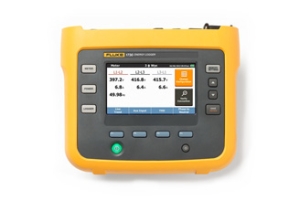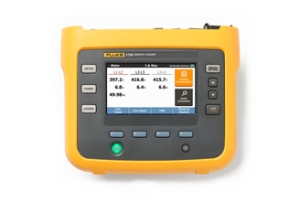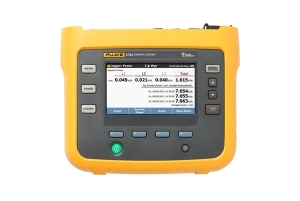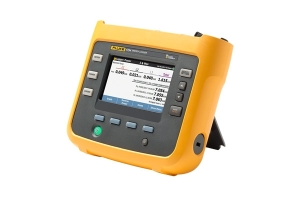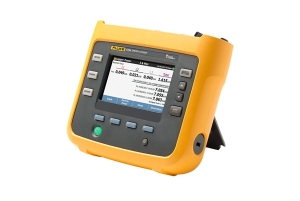Fluke 1732/B Three-Phase Energy Logger (No Probes)

- Choose the product you want and add it to your cart.
- Proceed to checkout and fill out a short form.
- Click on "Tap Payment," and a secure window will pop up.
- Select Tabby as your payment option within the pop-up.
- Enter your mobile number and receive an OTP code.
- Complete additional verification, such as providing your EID & other details.
- Enter your Full Name and perform ID Verification.
- Finally, press "Buy Now" to complete the purchase.
The Fluke 1732B Three-Phase Energy Logger with Fluke Connect introduces a new simplicity to discovering sources of electrical energy waste.
The Fluke 1732B Three-Phase Energy Logger with Fluke Connect introduces a new simplicity to discovering sources of electrical energy waste. Discover when and where energy in your facility is being consumed, from the service entrance to individual circuits. Access and share data remotely with your team via the Fluke Connect app so that you can maintain safer working distances and make critical decisions in real-time, reducing the need for protective equipment, site visits and check-ins.
Profiling energy usage across your facility helps you identify opportunities for energy savings, and provides you with the data you need to act on them. The new Energy Analyze software package allows you to compare multiple data points over time to build a complete picture of energy usage, which is the first step to reduce the cost of your energy bill.
Load Studies
Discover how much energy individual pieces of equipment are consuming when they are operating at minimum and maximum capacity. Check the capacity of circuits prior to adding additional loads (various standards exist for this process; in the US the NEC 220-87 is the recommended standard). Load studies can also identify situations where you might be exceeding the allowable load on the circuit, or when an agreed peak demand applies from the utility. For convenience, some load studies simply measure current, which makes installing measuring equipment quick and easy. It is often recommended that load surveys be performed for 30 days, so that all typical load conditions are encountered during the test.
Energy Assessments
Quantify energy consumption before and after improvements to justify energy saving devices.
Energy Surveys
Users often ask where measurements should be taken for an energy survey; the answer is multiple points within the facility. Start at the main service feeders, then compare the power and the energy measured there, with the readings from the utility meter to ensure that you are receiving the correct charges. Then move downstream to the larger loads; these should be easy to identify by the current rating of the electrical panels downstream of the service entrances. Measuring at many points will allow a full picture of energy usage across the facility to emerge. The next question users typically ask, "How long should an energy survey last?" This, of course, depends on the facility, but it is recommended that you measure for a period of time that matches a typical facility activity period. If the facility operates over a five day work week, with down-time on the weekend, a seven day survey will most likely capture its typical conditions. If the facility operates at a constant level for 24 hours a day, 365 days a year, a single day could be reasonably representative, as long as you avoid scheduled maintenance. To capture a full picture of the facility's energy usage, it is not necessarily required to have measurements made simultaneously at every consumption point in the facility. To get a comprehensive picture, spot measurements can be made and then compared on a sliding timescale. For example, you could compare the service entrance results from a typical Tuesday between 6:00 am and 12:00 pm, with those of a larger load in the facility. Typically, there will be some correlation between these profiles.
Logging Related Analog Measurements
When conducting energy studies, it is useful to log related analog measurements such as temperature, voltage, current and/or pressure. These variables provide a better overall picture of operating conditions and allow you to correlate asset performance data with energy consumption. Correlating these variables provides more of the data that you need to make cost-saving performance adjustments.
Power and Energy Logging
When a piece of equipment is operated it instantaneously consumes a specific amount of power in watts (W) or kilowatts (kW). This power is accumulated over the operating time and expressed as energy consumed in kilowatt hours (kWh). Energy is what your electric utility charges for; there will be a standard charge from the utility per kilowatt hour. Utilities may have other additional charges, such as peak demand, which is the maximum power demand over a defined period of time (often 15 or 30 minutes).
There may also be power factor charges, which are based on the effects of the inductive or capacitive loads in the facility. Optimizing the peak demand and power factor often results in a lower monthly electricity bills.
Simplified Load Studies
For situations where it is either difficult or impractical to make a voltage connection, the "Simple Load Study" feature allows users to perform a simple load study by measuring current only. The user can enter the nominal expected voltage to create a simulated power study. For accurate power and energy studies, it is required to monitor both voltage and current, but this simplified method is useful in certain circumstances.
Easy to Use
An innovative tangle-free flat voltage lead makes connections simple and reliable; the instrument's intelligent 'Verify Connection' feature automatically checks to make sure the instrument is connected correctly and can digitally correct common connection issues without having to disconnect measurement leads.
The detachable power supply can be conveniently and safely powered directly from the measured circuit. No more searching for power outlets, or having to run multiple extension cords to the logging location.
Analysis and Reporting
Capturing logged data is just one part of the task. Once you have the data, you need to create useful information and reports that can be easily shared and understood by your organization or customers. Fluke Energy Analyze Plus software makes that task as simple as possible. With powerful analysis tools and the ability to create customized reports in minutes, you will be able to communicate your findings and quickly solve problems so you can optimize system reliability and savings.
| Product Name | Fluke 1732/B Three-Phase Energy Logger (No Probes) |
|---|---|
| Weight | 0.45 Kg |
| Manufacturer | Fluke |
| Color | Orange |
-
Icon
Email
-
Icon
Telephone
-
Icon
Shipping Worldwide
Yes, that's right, we do!













